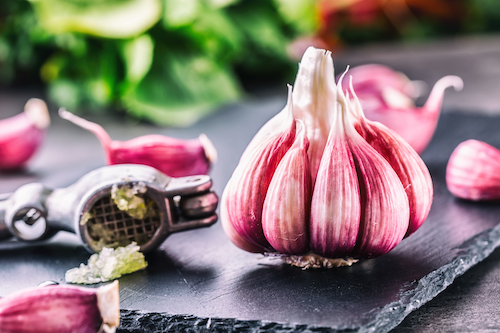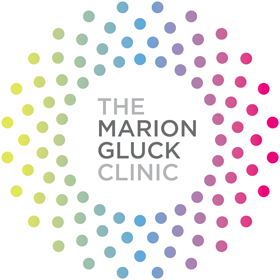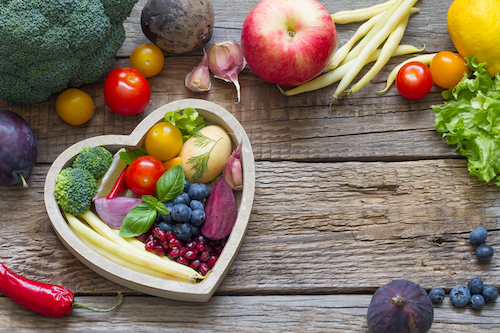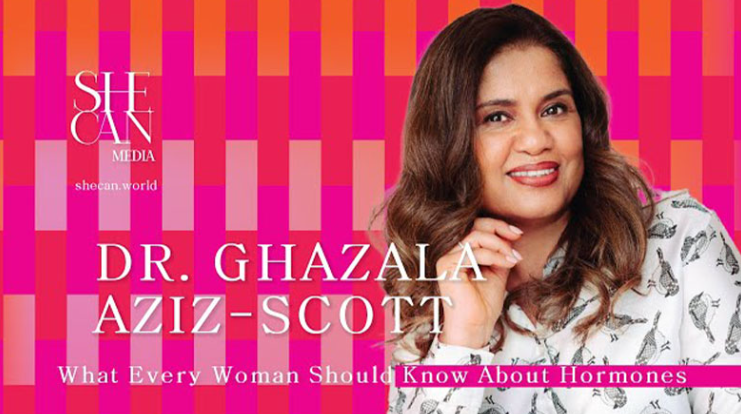
Garlic (Allium sativum) is one of those foods that can truly be called “food medicine”, a real gem that has been used for its medicinal properties since ancient times. Nowadays, garlic is the number one food when it comes to supporting your heart health, promoting blood flow through vessels and improving blood supply to organs and tissues. No wonder it plays such an important role in protection from cardiovascular disease (CVD).
CVD is a general term for all conditions affecting the heart or blood vessels, including coronary heart disease, angina, heart attack, high blood pressure, stroke and vascular dementia. There is extensive research on the health benefits of garlic in CVD, particularly in reducing blood pressure and cholesterol. In fact, epidemiologic studies show an inverse correlation between garlic consumption and progression of CVD.
Additionally, garlic is a potent anti-bacterial and anti-fungal (making it a great addition to an anti-candida protocol), anti-parasitic, is a great immune system booster (excellent for preventing and treating the common cold and flu), and it may help with insulin sensitivity, prostate cancer, bone health, and detoxification of heavy metals in the body. There are also well-known theories surrounding garlic that it increases libido and chases away mosquitos (and vampires!). This is due to its role in increasing blood flow, including to sexual organs, although like vampires this has not been proven and there is no evidence supporting these theories.
Garlic, blood pressure and cholesterol
High blood pressure (or hypertension) can lead to heart attacks and strokes. Several studies on humans have found high dosage garlic supplements to have a significant impact on reducing blood pressure in people with high blood pressure. Garlic’s blood-thinning properties reduce the chances of clot formation, therefore helping to lower the risk of stroke and other circulatory issues.
High cholesterol can contribute to atherosclerosis (when plaque builds up inside the arteries) and coronary artery disease. Studies have shown that garlic supplements can reduce total and LDL cholesterol (known as “bad” cholesterol), particularly in those who have slightly elevated cholesterol levels, while levels of HDL (the “good” form) of cholesterol do not seem to be affected. The duration of the treatment in the different studies varied from 2 weeks to 3 months.
Garlic and the menopause
The decline in oestrogen observed during menopause is a known predisposition factor for CVD because the heart and blood vessels become less protected, affecting several menopausal and postmenopausal women. Interestingly, research shows that supplementation with 80 mg daily of aged garlic extract in postmenopausal women for 12 weeks reduced total and LDL cholesterol as well as homocysteine levels. High levels of homocysteine have been linked to an increased risk of heart disease.
How does garlic work?
Garlic contains components with very potent medicinal properties. One of its most important compounds is the sulfur-containing powerful antioxidant allicin, which responsible for its particularly strong odour, but also its health benefits. Allicin is produced from its inactive precursor called alliin by the process of crushing or chopping. Once allicin is produced, its potency decreases quickly and will disappear within one hour of crushing/chopping. Another sulphur compound responsible for its health benefits is S-allyl cysteine. Garlic is also a good source of vitamins C and B6, and manganese.
How to take garlic
Garlic can be consumed in its fresh raw form or as a supplement. Remember that raw garlic should be crushed or chopped and allowed to sit for approximately 10 minutes before eating, so it releases its beneficial compound allicin. In this way, garlic is a lot more potent than when left uncut or cooked. Garlic is an easy (and delicious) addition to many dishes. In savoury dishes, can complement soups, sauces, stir-fries and stews. A great way to eat garlic in its raw form is by adding it to home-made guacamole or to chopped cherry tomatoes mixed with olive oil on sourdough bread. Two to four cloves daily are considered safe. Supplements are available as dried garlic or aged (odourless form) in the form of capsules and tablets (consider taking a total of 600 to 1500 mg daily in divided doses) or herbal tincture (15 ml daily).
Garlic is usually safe although some people with gastric disorders can demonstrate sensitivity (such as nausea, heartburn or bloating). Also, if you have a bleeding disorder or take blood-thinning medications, talk to your doctor before increasing your intake of fresh garlic or taking a garlic supplement.
Lifestyle balance is key
Although garlic is a great addition to any regime if you would like to look after your heart and blood vessel health, remember that it is always important to think about your diet as a whole, rather than one ingredient. Therefore, a balanced diet rich in vegetables, fibre-rich wholegrains, wild oily fish (at least twice a week), nuts and seeds, and probiotic foods (such as kefir and sauerkraut to look after your gut health). Also reduce the intake of sugar, white carbohydrates, unhealthy fats particularly trans-fats, red meat (best consumed if organic free range and up to twice a week), salt and alcohol.
And finally, manage your weight through diet and exercise, do not smoke, and learn how to manage stress (read our blog on managing stress with meditation) as these are all high-risk factors for CVD.
Also read:
Adaptogens for stress and adrenal fatigue
The Truth about Menopause
Yoga from sunrise to sunset
References
Borlinghaus, Jan, et al. “Allicin: Chemistry and Biological Properties.” Molecules, 2014.
Dhawan, Veena, and Sanjay Jain. “Garlic Supplementation Prevents Oxidative DNA Damage in Essential Hypertension.” Molecular and Cellular Biochemistry, 2005.
Nantz, Meri P., et al. “Supplementation with Aged Garlic Extract Improves Both NK and Γδ-T Cell Function and Reduces the Severity of Cold and Flu Symptoms: A Randomized, Double-Blind, Placebo-Controlled Nutrition Intervention.” Clinical Nutrition, 2012.
Rahman, Khalid, and Gordon M. Lowe. “Garlic and Cardiovascular Disease: A Critical Review.” The Journal of Nutrition, 2006.
Ried, Karin, Oliver R. Frank, et al. “Aged Garlic Extract Lowers Blood Pressure in Patients with Treated but Uncontrolled Hypertension: A Randomised Controlled Trial.” Maturitas, 2010.
Ried, Karin, Catherine Toben, et al. “Effect of Garlic on Serum Lipids: An Updated Meta-Analysis.” Nutrition Reviews, 2013.
Ried, Karin. “Garlic Lowers Blood Pressure in Hypertensive Individuals, Regulates Serum Cholesterol, and Stimulates Immunity: An Updated Meta-Analysis and Review.” The Journal of Nutrition, 2016.92.
Seo, Dae Yun, et al. “Independent Beneficial Effects of Aged Garlic Extract Intake with Regular Exercise on Cardiovascular Risk in Postmenopausal Women.” Nutrition Research and Practice, 2012.
Sobenin, Igor A., et al. “Lipid-Lowering Effects of Time-Released Garlic Powder Tablets in Double-Blinded Placebo-Controlled Randomized Study.” Journal of Atherosclerosis and Thrombosis, 2011.




